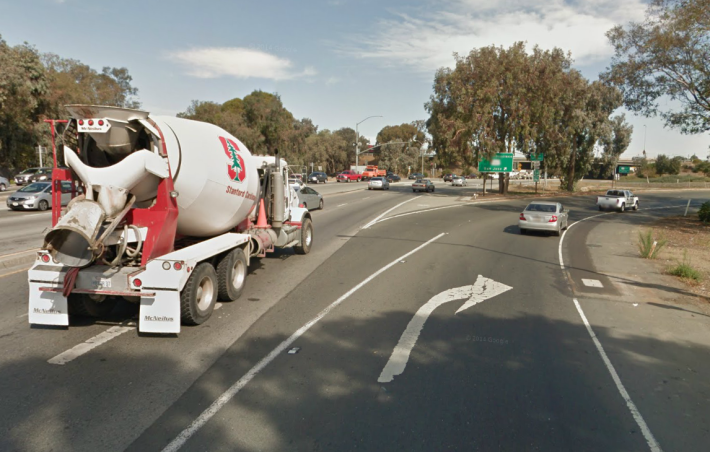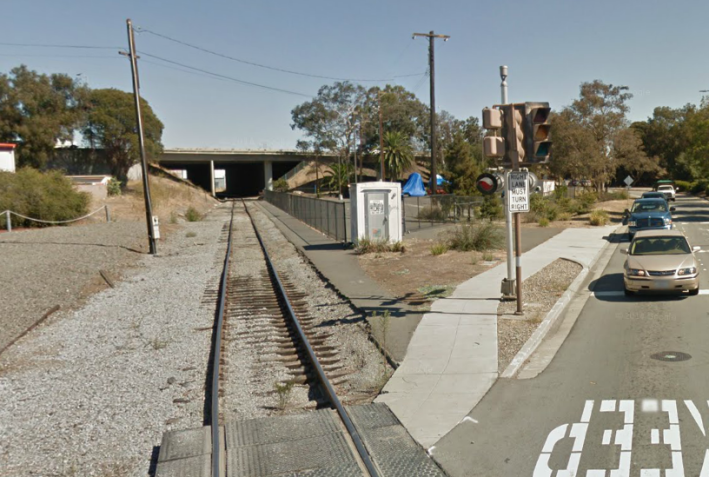Redwood City Interchange Could Get More Dangerous for Walking and Biking
5:12 PM PST on January 21, 2015

Redwood City has begun environmental review on a planned reconstruction of the Highway 101 interchange at Woodside Road, as well as two major intersections on either side of the highway -- projects designed to move more cars. Some of the proposed designs would retain existing traffic ramps that are hazardous to people walking and bicycling, and Woodside and Broadway Street would both be widened.
"That's where the fatalities are, especially with truck drivers," said Redwood City resident Matthew Self. "These are the high-risk points where cars are speeding up to freeway speeds."
Alternatively, a design favored by bicycle and pedestrian safety advocates would replace all the on-ramps and off-ramps with large signalized intersections. All of the proposed designs include two multi-use paths, one sidewalk, and bike lanes.
City and county transportation officials say the $60 to $90 million highway expansion project is needed to "alleviate existing and projected peak hour traffic congestion" in the area. If the project is approved, the interchange would carry more cars with new traffic lanes, intersections, bridges, and possibly a tunnel on Woodside.
"The project purpose is to alleviate existing and projected peak hour traffic congestion in the area, and to enhance mobility and safety," said Scott Kelsey, Senior Transportation Manager for URS, the consulting firm hired by Redwood City to guide the project through the required environmental reviews. "There's also the lack of adequate bicycle and pedestrian accommodations, we are going to fix that too."

Currently, the half-mile stretch of Woodside that crosses under Highway 101 connects to six different traffic ramps connecting to the highway, creating dangerous conditions for people on bikes as well as pedestrians who cross the ramps. No sidewalks, crosswalks, or bike lanes have been installed.
Woodside is acknowledged by Redwood City's 2010 General Plan to be “one of the most significant barriers to pedestrian and bicycle travel. Lack of sidewalks, lack of safe crossings, and high vehicle volumes and speeds are inconvenient, present safety concerns, and discourage pedestrians and bicyclists from traveling along or across Woodside Road."
Despite the General Plan's first Circulation Element [PDF] policy to "...reduce vehicle trip generation and vehicle miles traveled," all of the designs would substantially increase capacity for motor vehicle traffic through the interchange by adding lanes to Woodside and Broadway, and by replacing the intersection at Woodside and Veterans Boulevard with new bridges over Woodside that would connect directly to Highway 101.

"The flyover [bridges over Woodside] address a major movement of traffic at the interchange itself which is northbound Highway 101 to northbound Veterans Boulevard and the reverse trip, so it offers a major traffic congestion relief component," said URS Transportation Engineer Paul Krupra.
Each of the four alternatives [PDF] recommended by URS to be studied in the project's environmental impact report would widen Woodside from four to six lanes for most of its length between Blomquist Street and Bay Road, and widen it to eight lanes underneath Highway 101. Plus eight lanes for motor vehicle traffic, there is space for one sidewalk, one multi-use path, and bike lanes to Woodside without reconstructing the Highway 101 bridge overhead. Another multi-use path would be built along the Union Pacific rail line between Veterans and Seaport Boulevard just west of the interchange, allowing people walking and bicycling to cross Highway 101 while avoiding Woodside Road altogether.
"It's really critical that the Union Pacific path is an integral part of the design, so that we're not told to go get money elsewhere," said John Langbein, a local bicycle advocate, at a community meeting in November.

While street safety advocates welcome the car-free option provided by the new off-street path, any proposal that doesn't address the hazardous traffic ramps that connect to 101 would keep the highway crossing unusable for most people who live and work nearby and travel by bike or on foot.
"Preferred consideration should be given to Alternative 3, since it does not include any high-speed ramps," wrote the Silicon Valley Bicycle Coalition in a December 16 comment letter [PDF]. "High-speed ramps are not compatible with Pedestrian Enhanced Design," the letter stated, in reference to "Policy BE-25.5 of the Circulation Element of the Redwood City General Plan (2010)."
"To be safe for bicyclists," the letter continued, "the interchange design must not include any high-speed on-ramps or off-ramps. There is no way for bicyclists to cross these ramps safely. Multiple bicycle fatalities have occurred at nearby interchanges with high-speed ramps, including a 2010 fatality at 280-Alpine Rd. on a high-speed ramp that is similar to what is proposed for the northbound 101 on-ramp in Alternative 3A."
Alternatives 3A (a roundabout on Woodside on the north side of Highway 101), 3B (a tunnel for Woodside to pass under Broadway), and 8B (a new "Diverging Diamond" design), would all include high-speed traffic ramps, including two-lane on-ramps.
"It's extremely dangerous [for bicyclists] to have to cross two lanes of traffic making a right turn to get on the freeway," said resident Marc Beban.
Caltrans staff collected scoping comments on the project's EIR through December 20. The consulting team expects to present a Draft EIR in August 2015 and a Final EIR by January 2016. The interchange could then be constructed as early as 2021 if the San Mateo County Transportation Authority (SMCTA) chooses to fund it, and grants from state and federal sources are secured.
Stay in touch
Sign up for our free newsletter
More from Streetsblog San Francisco
SFMTA Starts West Portal Outreach
Agency presents plans to block traffic from crossing in front of the train station



